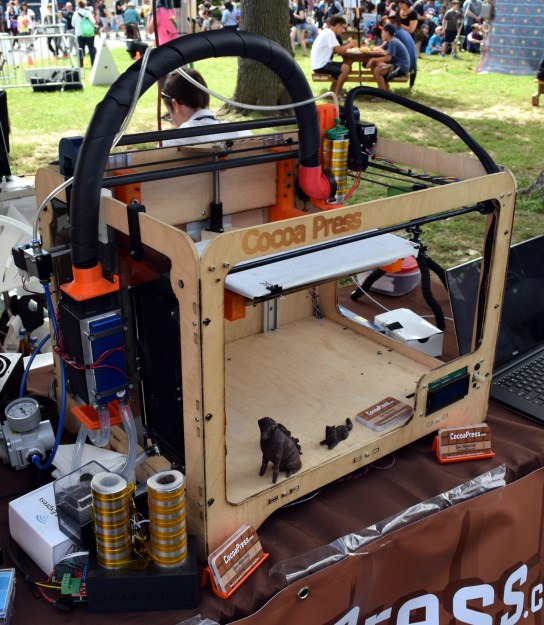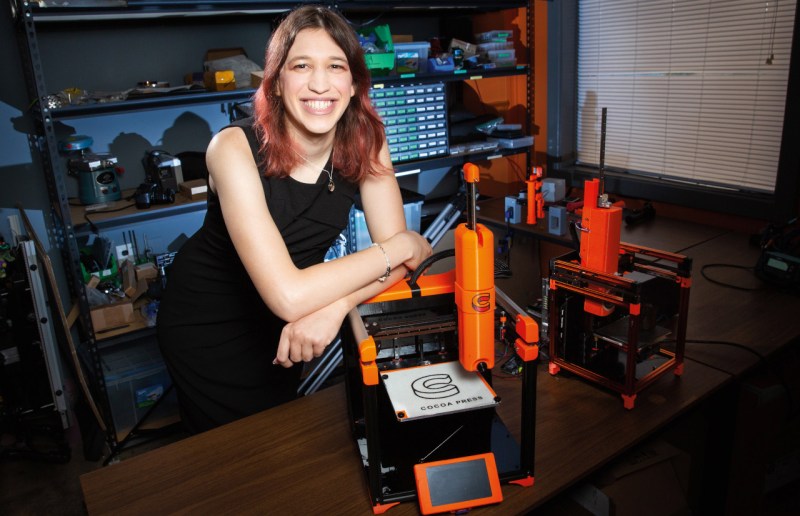Ultimately, the goal of Hackaday is to shine a light on the incredible projects coming from the hardware hacking community. In the vast majority of cases, said projects end up being one-off creations — a clever solution that solved a specific problem for the creator, which may or may not be directly applicable to anyone else. But occasionally, perhaps one in every few thousand projects, we see an idea that’s compelling enough to become a commercial product.
Today, we’re happy to add the Cocoa Press to that list. Creator [Ellie Weinstein] has recently unveiled a commercialized version of the chocolate 3D printer she’s been working on for several years, and true to the maker spirit, it’s being offered as a DIY kit. You can currently put a $100 USD deposit on the final product, which is expected to ship before the end of the year. Assembly time is estimated to be around 10 hours and no previous experience with building 3D printers is required, though we’re sure it wouldn’t hurt.
We first came across the Cocoa Press back in 2018, when we ran into it at the World Maker Faire in New York City. That original printer, clad in plywood and festooned with pipes and wires, bears little resemblance to the compact and sleek unit [Ellie] is selling now. But the core idea remains the same — pressure is applied to a syringe filled with warmed chocolate (or potentially other foodstuffs) to smoothly extrude a bead of deliciousness onto the printer’s bed.

The 2018 version used compressed air to force the chocolate out of the nozzle, while the final hardware has switched to a more conventional leadscrew and stepper motor arrangement. Also gone is the complex liquid cooling system used on the prototype. By keeping the chocolate just warm enough to smoothly extrude through the printer’s 0.8 mm nozzle, the new Cocoa Press doesn’t need any cooling at all. Once the chocolate touches the non-heated bed surface it cools and solidifies rapidly.
The Cocoa Press kit is based on the Voron 0.1 design, and uses the ever-popular Marlin firmware, so we’re optimistic about the ability to modify and repair the machine going forward. It’s also fully compatible with popular open source slicers such as PrusaSlicer, so there’s no worries about getting burned with a chocolate-printing-as-a-service contract in the future. There’s no material lock-in either; while the machine has been designed around a specific blend of chocolate, [Ellie] says there’s nothing stopping you from using your own mix.
Compared to the evolved version of the printer we saw during the 2019 Philadelphia Maker Faire, we’re impressed with how small the final product is. The extruder is still far larger than you’d see on a traditional FDM desktop machine, but there’s really no way around that given the system’s design. Trying to pump molten chocolate from a tank located elsewhere on the machine would be a nightmare, so the syringe inside the extruder needs to hold as much material as possible. In this case, that’s 70 grams.
If you’d like to see more of the nuts and bolts of the Cocoa Press kit, check out the walk-through [Ellie] did with [MandicReally] below. We’re eager to see these machines get in the hands of makers, as the ability to create edible 3D prints is one of those technologies that has seemed perennially out of reach for hobbyists.
















Been very cool to see this printer develop over the years, wish them luck. Seems to be this could print all kinds of pastes, so should be interesting to see what kind of aps people can come up with once its in the wild.
Now, what this needs is a lidar height mapper, so it can print on top of things like muffins or croissants.
Finally a use case for a 8×8 time-of-flight sensor, i snatched from a convention (ST VL53L5CX 20mm min distance)
True time-of-flight LIDAR, like the VL53L5 uses, is useless for bed leveling: precision is way too poor. I’m referring to the fake ‘lidar’ that folks like Bambu Labs use for bed height/first layer mapping: just a cheap optical triangulation sensor. Good precision, mediocre accuracy (even Bambu backs it up with a touch probe), but maybe good enough to map the top of a muffin.
The precision would have to be similar to bed leveling though because you’re still mapping the target print surface
Because it seems it’s the only part differing from a standard 3D printer, it would be great if we could buy the extruder/heater as a stand-alone to put in a different 3D printer. However, that would probably need to use a special heating plate and NO stick glue !
This would be great for prototyping, if the print doesn’t work out just eat it!
You’ll get fat.
Username checks out.
Clearly states, “intended for users with prior 3D printing experience, as it requires assembly and 3D printing your own parts.”
So, $1500 for an incomplete kit??? GTFO
TNO already researched chocolate 3D printing in 2014. (https://vakbladvoedingsindustrie.nl/en/article/3d-food-printing). In the netherlands, companies such as Felixfood and byflow tried it. They sold it to some five star restaurants but outside that demand has been low. These printer can not print a complete meal.
These printers can’t even print out proper chocolate, it’s chocolate flavoured sludge.
Which makes it ideal for 5-star restaurants!
The patrons will rave about its new dimensions in flavor!
Are you saying chocolate isn’t a complete meal?
Hi Rik, you are quite well informed! Just to add something to set the record, the student executing the TNO project back in the day is the co-founder of byFlow BV.
Manufacturing and traning to use machine for the HoReCa sector was/is a mastodontic task, that makes for a less compelling business opportunity for the target audiance that can go by without any knowledge of 3D printing and technology in general (unlike the DIY 3DP enthusiast croud).
The bigest ordeal of food printing is the reliance on syringes, that are extremely labour intensive and prone to all kinds of failures/problems. It’s a design flaw that even the most succesful company that 3d prints food (for real, not marketing) BluRhapsody by Barilla, is fighting every day with their TNO based syringe machines, even after the better part of a decade to optimization.
I support Ellie and would love to meet her in person if she pass by an event in the netherlands, but the hard truth that is half hidden in plain sight is that her syringe machine is not sold or equipped to print reliably real choccolate, but a easier to work with substance based on vegable fat called compound chocolate that doesn’t need tempering. Her previous machine equipped with cooling had a chance, but the risk of un-tempering the real choccolate is too high, so now the effectivly gave up on chocolate an moved to compound, removing a lot of complexity and cost…. and taste.
I wish her all the best for the launch and unique business model (based on the OSource Voron project), i only wish the marketing and promotion would stick to “cocoa paste printing ” or “chocolate-like paste printing”, but we understand how hard is to launch a product
I can’t see any link to the sources?
The voron is GPL3, this is a derivative work of it.
Got to try some at MRRF last year. Super low fat content to avoid burning. terrible chocolate, but not nasty.
Because it uses Palm Oil instead of Cocoa Butter in the material the output can’t legally be called “chocolate” in the USA although it is legal to do so in the UK.
It is understandable.
Tempering chocolate is a real pain that requires a huge amount of technical knowledge ( or luck)
Using syringes to print is a huge pain of manual laubur and time
3d printing a substance that is liquid for seconds is a huge pain
Compound chocolate made with palm oil fat is the quick way out used by mycusini and the vat majority of food printers to avoid the first hurdle, the tempering, alltogether.
the only ones using real chocolate currently are callbout Monalisa 3d (it uses external tempering machines, cost a couple millions of hw), Chocomate 3 (uses syringes with custom made chocolate from germany, then relies on external cooling equipent for climate control) and the new byflow (it actually tempers while depositing, plus built in climite control to control solidification) but we aren’t selling it lol too bad